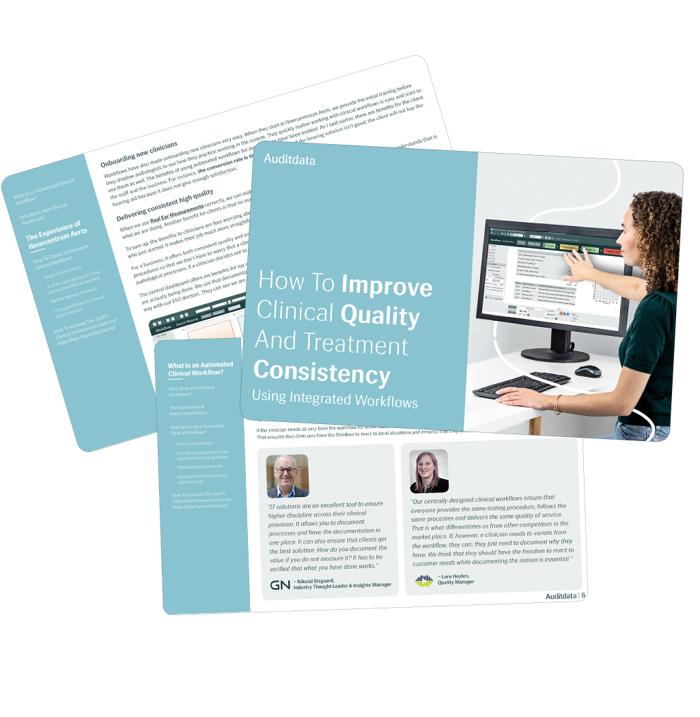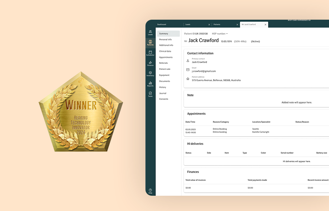
Setting and discussing key performance indicators (KPIs) is a tricky business. Are they understood? Are they relevant? Do they make your staff perform better? They are only as valuable as you make them, and they require time, effort, and employee buy-in to live up to their high expectations. Many hearing care centers fail due to setting irrelevant indicators, having too many measure points, or because they don't communicate them or follow up on them properly. Another issue is when the KPIs you set are not connected to the overall strategic vision of your hearing care clinics. This means that even if the measurements are reached, the overall strategic goal might not be. Setting objectives and aligning them from the top-down is key to reaching your strategic targets.
In this blog, we will focus on how to set strategic targets and then connect and define relevant personal KPIs to those targets.
Setting Strategic Targets
Setting key performance indicators for an organization usually happens during the strategic planning phase (usually before the year starts). The goal is to ensure the entire organization is aligned towards the same objectives. Doing this correctly can help you move your business forward effectively. Many standards have been created that can help you. For instance, Policy Deployment is a simple structure to follow. You start from the top and move your way down in the hierarchy. Or you might want to get inspiration from Bernard Maar & Co.

When running a retailer in hearing care, set a growth target for your bottom-line. Depending on your locations, age of the clinic, willingness to invest, and other factors, this target might differ. You might also have targets on hearing quality, but this blog will focus on financial outcomes only. Though it’s true that higher clinical quality is closely connected to improving conversion rates and customer satisfaction.
Free Guide
How to Improve Clinical Quality and Treatment Consistency using Clinical Workflows
Few within the industry have introduced protocols and integrated them into their daily clinical workflows. In this guide, we take a close look at why centrally controlled, automated clinical workflows make sense and deep dive into the different facets within. Additionally, we will investigate how good data analysis can help activate staff members and make better commercial decisions.

Drilling Strategic Targets Down To KPIs
In hearing care, one size does not fit all. There are a few tips and tricks we would like to share with you about using KPIs effectively with your staff and ensuring they focus on the right things, including:
How to Make Relevant KPIs For Your Different Staff Types
To change your employees’ behavior, your KPIs must be relevant for them and something that is feasible and realistic to reach. Overall revenue, bottom lines, or other financial factors might be relevant for you to measure. But for your staff, this is not personal, and they often believe they cannot impact these numbers at all... meaning, they will not change their behavior. Another classic failure when setting KPIs is to have too many targets to reach, meaning lower financial value on each of the metrics.
To engage your staff, give them clearly outlined KPIs related to their daily work, and ensure that the tasks they perform are relevant to your company’s strategic direction and your bottom-line. Lastly, keep it simple. Your employees should be measured on no more than 2-5 KPIs each year.
To be certain that your KPIs are clear and understandable, make use of SMART definitions and always keep them related to your overall strategic objectives and goals. You can read more about SMART goals here.
Below, you can find inspiration on how to measure KPIs for employees in different departments.
The Marketing Department
The marketing department should be measured on quality rather than quantity. It’s easy to attract a person to a clinic by promising free ice cream, but this is not valuable. There are different ways of setting up a clinic. If your marketing department is responsible for attracting, quality leads and calling them, you should measure marketing employees on:
- Number of qualified leads – also called Marketing Qualified Leads
A Marketing Qualified Lead is someone who has signed up for an event, newsletter, or other activity. These leads are important to keep a growing pipeline – but for these to be converted, you’ll need to nurture them and make them sales qualified.
- Number of booked clients – also called Sales Qualified Leads
This shows how good your marketing department’s campaigns are at attracting and converting leads to appointments. - % Show-up rate (the threshold here should be above 70%)
Marketing staff should ensure that the clients are well informed about the appointment and send them reminders in the days leading up to the visit. - % Of clients booked with a hearing loss (the threshold should be above 70%)
This is the quality of the leads booking, which could also be improved by qualifying the hearing-loss prior to booking.
The Front Desk Staff

The front desk staff has many roles and responsibilities. They might be the booker, a lead generator, and a helping hand for the audiologist. They can also be a great source of revenue for your shops. If they are the ones booking the leads, they should be measured on:
- % Show-up rate (the threshold here should be above 70%)
Front desk staff should ensure that the clients are well informed about the appointment and that a reminder has been sent in the days leading up to the visit.
- % Of clients booked with a hearing loss (the threshold should be above 70%)
This is the quality of the leads booking, which could also be improved by qualifying the hearing loss prior to booking.
If they are not booking leads, other great KPIs could be:
- Number of clients handled at the front desk without interference from a service provider
This means that the front desk staff can offload some of the work from the often very busy audiologists and make space in the calendars for new incoming leads.
- % of clients buying an accessory
It is often the front desk staff who can assist with accessories, which can be shown in the waiting area. Additionally, the front desk staff should mention the benefits of accessories when a client has challenges.
- % of clients introduced to the friends and family program
A friends and family program is a great way for your clients to refer their contacts to your clinic. The front desk staff often has a central role here but, as with everything, if it is not measured, it is not done. You can read more about how to set a friends and family program up here.
The Audiologists

Whatever you call them in your hearing care clinic, these are the staff members who have the closest dialogue with the clients, examine their ears, and recommend a solution for their hearing loss. In many places, we see that the audiologists are measured on “conversion rate” from show-up. But this is actually not fair, the audiologists should be measured on:
- The conversion rate from HL detected and hearing aid trial
- From hearing aid trial to buy
- Total revenue from new and existing clients
- Total average selling price (ASP) per client, including accessories
How To Communicate The Goals Clearly
KPIs should be set correctly and communicated clearly, so employees actively work to reach their targets. Make sure employees from all departments are informed about their KPIs individually and inform them of your incentive scheme if they reach these numbers.

Employees’ fixed salaries should have an additional bonus percentage attached to them based on the set KPIs and thresholds. Decide:
- What is the expected bonus in % of salary or amount per month/quarter/year
- How are the KPIs defined? Make sure the staff members understand this
- What is the weight between the different KPIs (for marketing; is it 33/33/33% for the suggested KPIs, or do you want to measure the quality higher?)
- What are the targets and when should they be met?
- How often you’ll have follow-up meetings
How To Follow Up On Performance
To ensure that this is not an initiative that is only followed up upon annually, in all 1:1 meetings, including a run-through of how the individual is performing compared to the target. The focus should always be on improving the employees’ value-generating activities. In a Practice Management Software, you can easily get reports on each staff member to see how they are performing. With benchmarks and personal data points, you can set key performance indicators (KPIs) for your staff and easily track these together with them to optimize the outcomes of their efforts. This will make the follow-up much easier. However, make sure that the staff inserts data correctly in the system. Also, there might be incentives that clash (for instance, the hearing loss rate is good for the marketing department, but not for the audiologist if it is not converted to a trial).
At the individual meetings, the targets and performance should not be punitive for the underperforming employees. Rather, coach them on how to perform better. You might give them benchmark data from other hearing care clinics or staff in similar positions. Show them strong performance data and explain what these employees have done to become this good. And for the good performers, tell them where they are doing well but encourage them to become even stronger by showing them KPIs where other employees are performing better. This can be a great way to achieve ongoing optimization and share learnings between departments and staff.
After each selected performance period, sit down with your employees and evaluate how they did, and which bonus they deserve. At this meeting, set the expectations for the upcoming period to be certain they’re prepared to perform and that you are aligned on their target KPIs.
Communicate Success And Status On Overall Performance

At the end of the year, evaluate the overall performance of your hearing care centers and see where you are according to the objectives set. Communicate these results to your staff and celebrate successes. You might want to spotlight some “best practices” to demonstrate specific successful teams or team members so other employees can learn from their efforts.
By following these guidelines, you can successfully use KPIs to improve the overall performance of your hearing centers. Auditdata's Standard Discover Reports can help you access real-time data and segment this all the way down to staff level.
Other Blogs You Might Enjoy:

How to Onboard Staff in Retail Hearing Centers
To help hearing professionals and hearing clinic owners how to successfully and seamlessly onboard and train new staff.

How to Calculate Productivity In Your Hearing Clinic and Why it Matters
Your hearing care clinic must track productivity to manage your business better. This article explains why understanding, calculating, and boosting productivity is essential, and provides tips on how to accomplish this.

4 Crucial Conversion Rates to Improve in Hearing Care
In hearing care retail, there is often a discussion about how to increase conversion rates, or help-rates as some prefer to call it. Many audiologists are measured on shop performance, conversion rates, and sales, and are rewarded according to these KPIs.
Don't Miss Out On the Latest Insights On Audiology
Sign up today to receive exciting updates, tips, and the latest newsletters from Auditdata.





